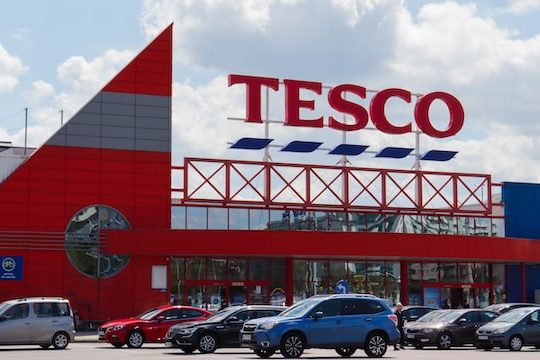Before we dive deep into the SWOT analysis, let’s get the business overview of Tesco. Tesco plc is a British multinational retail company specializing in the grocery and general merchandise sector.
It was founded by Jack Cohen in 1919 and has grown to become one of the world’s largest retailers. Tesco operates across multiple countries, with its primary market being the United Kingdom. Here’s an overview of Tesco’s business:
- Market Position: Tesco is the UK’s leading supermarket, holding a significant market share in the country’s grocery sector. It also has a strong presence in other countries, including Ireland, Central Europe, and Asia.
- Store Formats: Tesco operates various store formats to cater to different customer needs, including Extra, Superstore, Metro, Express, and One Stop. These formats range from large hypermarkets to smaller convenience stores.
- Product Range: The retailer offers a broad range of products, including groceries, clothing, household items, and electronics. It also has a robust private label offering through its exclusive brands, such as Tesco Finest, Tesco Everyday Value, and F&F.
- Online Presence: Tesco’s robust online platform allows customers to order groceries and other products through its website and mobile app. The company offers home delivery and click-and-collect services to provide convenience to its customers.
- Loyalty Program: Clubcard, Tesco’s loyalty program, rewards customers with points for their purchases, which can be redeemed for discounts, vouchers, or other benefits. This program helps Tesco maintain customer loyalty and gather valuable consumer data.
- Corporate Social Responsibility: Tesco has implemented various sustainability initiatives, including reducing food waste, minimizing plastic usage, and sourcing products ethically. It aims to become a zero-carbon business by 2050.
- Financial Performance: Tesco has demonstrated strong financial performance, consistent revenue, and profit growth. The company focuses on cost-saving measures and operational efficiency to maintain its profitability.
- Acquisitions and Partnerships: Tesco has pursued strategic acquisitions and partnerships to expand its market reach and diversify its business. Notable acquisitions include the UK food wholesaler Booker Group and the convenience store chain One Stop.
In its 2021/2022 financial year, Tesco’s annual revenue amounted to more than 56 billion British pounds in the United Kingdom and the Republic of Ireland. This was an increase of over three billion pounds compared to the prior fiscal year. The company’s profit in the UK and the ROI increased to 2,191 million in 2021/2022.
Here is the SWOT analysis for Tesco
A SWOT analysis is a strategic planning tool used to evaluate the Strengths, Weaknesses, Opportunities, and Threats of a business, project, or individual. It involves identifying the internal and external factors that can affect a venture’s success or failure and analyzing them to develop a strategic plan. In this article, we do a SWOT Analysis of Tesco.
SWOT Analysis: Meaning, Importance, and Examples
Strengths
- Market Leadership: As the largest supermarket chain in the UK, Tesco enjoys significant market share and brand recognition. This allows the company to exert considerable influence over suppliers and to benefit from economies of scale.
- Diverse Store Formats: Tesco’s various store formats cater to different customer needs, from large hypermarkets to small convenience stores. This flexibility enables Tesco to reach a broader customer base and adapt to changing market conditions.
- Strong Private Label Brands: Tesco’s private label products, such as Tesco Finest, Tesco Everyday Value, and F&F, offer customers high-quality goods at competitive prices. These brands help the company differentiate itself from competitors and boost profit margins.
- Robust Online Platform: Tesco’s online presence and e-commerce capabilities allow it to reach customers who prefer online shopping. This has become particularly important amid the growth of e-commerce and changing consumer behaviors.
- Effective Loyalty Program: Tesco’s Clubcard program helps the company retain customers by offering them rewards for their purchases. The program also provides Tesco with valuable consumer data, which can be used to improve marketing and tailor offerings to customer preferences.
- Efficient Supply Chain Management: Tesco’s effective supply chain management enables the company to minimize waste, reduce costs, and ensure the availability of products in stores. This helps the company maintain competitive pricing and high levels of customer satisfaction.
- International Presence: With operations in multiple countries, Tesco benefits from diversified revenue streams and reduced reliance on any single market. This international presence also allows the company to learn from different markets and apply best practices.
- Focus on Corporate Social Responsibility: Tesco’s commitment to sustainability and ethical practices enhances its corporate reputation and appeals to environmentally and socially conscious consumers. This focus also helps the company comply with regulatory requirements and manage risks associated with environmental and social issues.
Weaknesses
- Overreliance on the UK Market: While Tesco has an international presence, most of its revenue comes from the UK market. This makes the company vulnerable to economic fluctuations, changing consumer preferences, and increased competition in the domestic market.
- Price Competition: Tesco faces intense price competition from discount retailers such as Aldi and Lidl, which may pressure its profit margins. To maintain its market share, Tesco may need to lower prices or increase promotional activities, which could impact profitability.
- Store Size and Format Challenges: Tesco’s larger store formats, such as Extra and Superstores, have faced challenges due to changing consumer preferences towards online shopping and smaller, local stores. Adapting these store formats and managing underperforming stores can take time and effort.
- Reputation Damage from Past Issues: Tesco has faced several scandals in the past, such as the 2014 accounting scandal and issues related to supplier mistreatment. These incidents can damage the company’s reputation and erode customer trust.
- Complex Organizational Structure: As a large multinational corporation, Tesco has a complex organizational structure that can lead to inefficiencies, slower decision-making, and challenges in implementing changes across different business units.
- Difficulty in Sustaining Growth: Tesco’s size and market share make it difficult for the company to grow substantially in its core markets. Expanding into new markets or product categories can be challenging and risky, requiring significant investment and adaptation to local market conditions.
- Regulatory Compliance: Tesco operates in a highly regulated industry with strict rules regarding food safety, environmental impact, and employee rights. The company must constantly monitor and adapt to regulation changes, which can be costly and time-consuming.
- Challenges in International Markets: Tesco has faced difficulties in some international markets, such as withdrawing from the US market and selling its South Korean business. These experiences highlight the challenges of expanding and maintaining a presence in diverse markets with different consumer preferences and competitive landscapes.
Opportunities
- Expansion of Online and Digital Services: As e-commerce grows, Tesco can further invest in its online platform and delivery services to meet increasing consumer demand for convenience and seamless shopping experiences.
- Strengthening Private Label Offerings: Tesco can expand and improve its private label product range to offer customers more options at competitive prices, enhancing customer loyalty and boosting profit margins.
- Focus on Healthier and Sustainable Products: As consumers become more health-conscious and environmentally aware, Tesco can capitalize on this trend by offering a more comprehensive range of healthier, organic, and eco-friendly products.
- Expansion into Emerging Markets: Tesco can explore opportunities to enter high-growth emerging markets, which could provide significant growth potential and diversify its revenue streams.
- Partnerships and Strategic Alliances: By forming strategic partnerships with suppliers, technology providers, or other retailers, Tesco can expand its product offerings, improve its supply chain efficiency, and strengthen its market position.
- Growth through Acquisitions: Tesco can pursue acquisitions of smaller retailers or niche brands to expand its market presence, diversify its product portfolio, and enhance its expertise in specific sectors.
- Enhanced Customer Experience: Tesco can continue investing in technology and data analytics to personalize in-store and online customer experiences. This can lead to increased customer satisfaction, loyalty, and repeat business.
- Development of New Store Formats: Tesco can experiment with new store formats, such as smaller urban stores or specialized stores focusing on specific product categories, to cater to evolving consumer preferences and changing shopping habits.
Threats
- Intense Competition: The retail industry is highly competitive, with Tesco facing competition from traditional supermarkets and discount retailers like Aldi and Lidl. These competitors may impact Tesco’s market share and profitability.
- Changing Consumer Preferences: As consumer preferences evolve, Tesco must adapt its product offerings and store formats to stay relevant. Failure to meet changing customer demands may result in reduced footfall and sales.
- Economic Uncertainty: Economic fluctuations and uncertainty can impact consumer spending patterns, affecting Tesco’s sales and profitability. This may be particularly relevant given Tesco’s reliance on the UK market.
- Regulatory Changes: Changes in regulations related to food safety, labor practices, and environmental standards can impose additional costs and operational challenges for Tesco, affecting its business performance.
- Technological Disruption: The rise of new technologies, such as online marketplaces and on-demand delivery services, can disrupt traditional retail models and threaten Tesco’s market share. The company must continuously invest in and adapt to new technologies to stay competitive.
- Currency Fluctuations: As a multinational corporation, Tesco is exposed to currency risks due to fluctuations in exchange rates. These fluctuations can impact the company’s financial performance and make international operations more challenging.
- Supply Chain Disruptions: Tesco’s complex supply chain can be vulnerable to disruptions caused by factors such as natural disasters, geopolitical tensions, or global pandemics. These disruptions can lead to increased costs, stockouts, and potential damage to the company’s reputation.
- Cybersecurity Threats: As Tesco relies heavily on digital platforms and data management, the company is at risk of cybersecurity threats, such as data breaches or hacking incidents. These threats can lead to financial losses, reputational damage, and legal penalties if not effectively managed.









